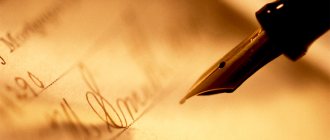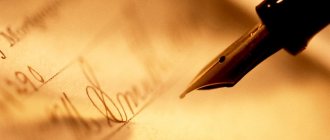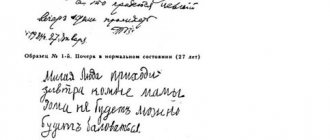It is not difficult to determine the character of any person by handwriting. The manner of writing speaks about temperament and even mood. There are books and textbooks on forensics that describe different types of handwriting with a detailed description of the person to whom it belongs.
When applying for a job, employers also pay attention to your letter. It is easy to determine the inner world of the applicant.
You can determine the compatibility of people by handwriting. Is your soulmate right for you?
A lot of information about a person's character is given by his writing style. Below we will show this with an example.
What is graphology?
Graphology is a science that studies the character of an individual based on handwriting. This name was given by the French priest Flandren. If we translate the word “graphology” from Latin, we will see that it consists of two simple words: grapho (I write) and logos (science).
Graphological analysis is a projective method of psychodiagnostics of a personality based on handwriting.
Why can you trust graph analysis?
Have you ever seen the same handwriting in two different people? You may have come across handwritings that are similar in style, but none are absolutely identical. Each person's handwriting is unique.
Why?
Handwriting is formed through fine psychomotor skills of a person. Accordingly, it is formed by what controls psychomotor activity: the central nervous system, as well as conscious and unconscious mechanisms of the psyche. The central nervous system and psyche determine the characteristics of a person’s personality and behavior. Thus, handwriting reflects what we call personality.
What does a person’s internal structure reveal?
This important aspect is recognized by the density:
- A closed person writes in a neat handwriting. If you manage to find an approach to her, then you will not find a better friend.
- An open, cheerful, friendly personality writes expansively . True, it is characterized by optionality and frivolity.
Letter connection:
Purposeful, logical, straightforward people do not make a break between letters. An extraordinary, talented person, from whom one should not expect logic, makes a gap between the letters.
Types of handwriting and their decoding
| Type of handwriting | Decoding |
| Sweeping | Generosity, but at the same time negligence |
| Compressed | Pickiness and pettiness |
| Illegible | Nervousness, haste, hyperactivity |
| Pale | Self-doubt, loneliness |
| Solid | Firmness, determination, confidence in yourself and your actions |
| Trembling | Depression, lack of self-confidence, exposure to fears |
| Large | Openness to new acquaintances, kindness, emotional stability |
| Small | Restraint, determination, secretive lifestyle |
| Stretching | Laziness, relaxation |
| wavy | Deceit, resourcefulness, adventurousness |
| Straight | Restraint, prudence, adequate self-esteem |
How to determine a person's character by handwriting?
Letter size
When analyzing handwriting, you need to take into account the size of the letters. For example, with age and due to overload, the size of letters in handwriting increases. Information obtained about the handwriting of people between 25 and 45 years old is considered the most reliable.
- Middle letters are the most common. If you come across these letters while studying the handwriting of a person, know that they do not contain specific information about their owner.
- Large written symbols indicate that the wearer has leadership qualities. Most often, such a person is quite emotional and easy to communicate with; he has no problems making acquaintances and starting new relationships.
- Lowercase (small) letters speak of determination and restraint. Often such letters indicate a secretive personality.
Pen pressure
How does pen pressure determine character?
- Quite a strong pressure is visible, and this characterizes an energetic, decisive, purposeful, efficient personality. This person always looks at life with optimism.
- If, in addition to strong pressure, there is also a strong bend, then we can say about a principled person who is strict with himself and those around him.
- In the event that there is a soft and rather weak pressure, then one can argue about weakness of will, about the absence of one’s own position or opinion. Such individuals often experience dependence on others. They also include such characteristics as: frivolity, slowness, vulnerability, thoughtfulness, difficulty in making decisions.
Fields
In addition to the listed characteristics, personality traits can be recognized by handwriting by looking at what fields a person leaves:
- If these are narrow fields, then we can say about such people that they are thrifty. In addition, such a person often exhibits pettiness. The narrower the fields, the more pronounced these qualities are; sometimes a thrifty person turns into a stingy one.
- If these are wide margins, then generosity can be attributed to the author’s personal characteristics. In specific cases, this quality of a person can turn into a negative one, namely wastefulness.
- Too wide brims characterize a person as vain, who constantly desires luxury and brags about it.
Line direction
- “Wavy” lines characterize people who are often prone to mood swings and adventure. In some cases, such lines indicate a person’s tendency to deceive and intelligence.
- Even lines, which are written as if along a ruler, make a statement about such personality characteristics as prudence and restraint. Most often, such people have adequate self-esteem and very correctly assess their capabilities.
- When it is clear that the line is rising, we can talk about an optimistic attitude towards life.
- If the line goes down, then the person has a pessimistic attitude towards life, and most often such individuals have low self-esteem.
Letter shape
- Angular and sharp letters. If you come across this style of writing when studying a person's character through handwriting, then know that it often hints at a sign such as selfishness.
- Round and smooth - pliability and pliability. Such a person treats everyone loyally and usually has difficulty achieving his goals.
Connectedness
What the tilt tells you:
- If there is a slight tilt to the left, then the author puts his own passions above others and is critical of others.
- With an independent nature, the letters “fall” strongly to the left. He has a personal point of view on any topic.
- If there is a slight tilt to the right. Before you is a balanced, calm person. He likes to be in good company and is not afraid of solitude either. But he is prone to unpredictable mood swings.
- A purposeful, persistent citizen writes with a strong slant to the right. This is a born leader. If he decides something, he will see it through to the end. In love, but jealous.
- If the text is not slanted, then you have a harmonious personality, but stubborn, combining emotionality and prudence. A decision is made only after a scrupulous analysis of the pros and cons. An example of leaning to the left.
The size of the letters is also important:
- A sociable person who learns everything new writes in large letters. This is a leader who is capable of joining any team and is endowed with the gift of persuasion.
- The author of small letters is a secretive, reserved and calculating person . In his work he is pedantic and not afraid of responsibility. Concentrates all attention on what he is doing.
- Creative people write broadly, while economical and rational people write narrowly. An example of narrow letters.
Innovator, conservative or revolutionary?
- Innovators accept change more easily than others and adapt to changing conditions. They like to use the new, non-standard and original, they spend less energy breaking habit and taking risks. They write more relaxed and quickly*, sometimes impulsively, and their handwriting can be described as inconsistent and bouncing. The world needs innovators to move forward.
- Innovators accept change more easily than others and adapt to changing conditions. They like to use the new, non-standard and original, they spend less energy breaking habit and taking risks. They write more relaxed and quickly*, sometimes impulsively, and their handwriting can be described as inconsistent and bouncing. The world needs innovators to move forward.
The desire to stand out: handwriting and signature
There are three common ways to express the desire to stand out in handwriting:
- When handwriting reflects low self-esteem, and the desire to stand out is compensated by the signature: it becomes larger than handwriting, complex, long, with additional elements.
- When the handwriting itself becomes complicated and decorated: loops and elements are added to it.
- If it looks like a copybook, then the person is trying to be effective within the accepted canon of beauty.
- If the handwriting is more careless and/or original, with a left slant, possible angles and/or impulsive movements, then the author of the handwriting is ready for more extravagant solutions.
The first two options reflect a person’s desire to look “better” than he is, to hide his real self. Such a person puts a lot of effort into his appearance, manners, behavior, he has good taste and sensitive self-esteem.
In the second case, a contrast to the world is added: to stand out not so much by beauty as by dissimilarity.
If the changes concern only capital letters, then the author of such handwriting likes to present himself brightly at the first meeting; he knows how to present himself in such a way that you definitely won’t forget such a person. He may have stable self-esteem, or he may have complexes and doubts, but his true nature will still quickly reveal itself.
How to find out personal qualities
- Signs of an intelligent person. Letters without decorative elements, the slope is either absent or barely noticeable. The distance between words is the same. The letters are round, neither large nor small.
- The stupidity is revealed by hooks, different distances between words, and uneven pressure. Particular attention is paid to capital characters.
- A hot-tempered personality is indicated by symbols that rise above the line. The endings of the last letters in a word go down below the lines.
- Strong-willed individuals apply even pressure, but the letters do not separate. The number of strokes is small. The letters are round and the writing is clear.
- Composure is revealed by uneven lines, but the last word is always in its place. The letters are written neatly, but the distance between the words is different.
- Balanced people have beautiful handwriting, although the text may seem difficult to read at first.
- Abusive people often underline the letters, but spell them out carefully.
Handwriting Analysis Examples
Irina Bukhareva is a handwriting expert. She did an analysis of the handwriting of the famous person Sigmund Freud.
There is too much negativity in the handwriting: distortions in forms. His main goal was to bring another person “to the surface.”
Handwriting also reveals many psychological problems and complexes: unhealthy changes in the pressure and tension of the stroke, variability in the middle zone, “brickwork” in the arrangement of words on the lines, fractures in the strokes. All this shows strong emotional stress, an inferiority complex, instability, anxiety, dissatisfaction, anxiety, anger, and depressive tendencies.
There are many contradictions within it. Constant fear, the need to protect yourself from the outside world, because... saw him as a threat, an opposition position. And it was precisely this desire to “bring others to clean water” that served as the true impetus for his theory.
Narcissist handwriting analysis
Everyone thinks that a narcissist is a narcissistic egoist, an educated pedant who believes that the whole world revolves only around his personality. He is a vain person, indifferent to other people's problems. This word is often used with negative connotations. But is this true from a psychological point of view? What is the nature of narcissism and how is this reflected in handwriting?
Test your character
How to pass the test? Each feature of the letter is given points, then added up.
Letter size:
- Very small - 3 points
- Small - 7
- Average - 17
- Large - 20
Letter slant:
- Tilt to the left - 2 points
- Slight tilt to the left - 5
- Tilt to the right - 14
- Sharp tilt to the right - 6
- Direct writing - 10
Letter shape:
- Round - 9 points
- Square - 10
- Spicy – 19
Line direction:
- The lines are creeping up - 16 points
- Sliding down - 1
- Straight - 12
Intensity (sweep and degree of pressure):
- Easy - 8 points
- Average - 15
- Very strong - 21
Connecting words:
- Connection of letters in a word - 11 points
- Letters separately from each other - 18
- Mixed spelling - 15
Test score:
- Neat letters, carefully written handwriting - 13 points
- Handwriting is uneven, some words are clear, but others are difficult to read - 9
- The letters are written carelessly, the words cannot be made out - 4










